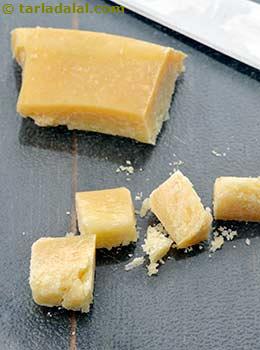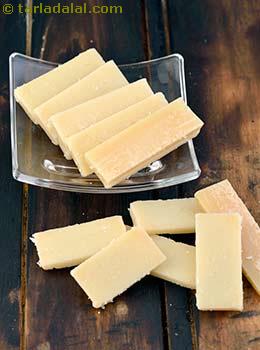![]() Also known as
Also known as
Parmegiano reggiano
Description
Parmesan cheese is an iconic hard cheese originally from Italy, widely used and produced all over the world. Within Europe, Parmesan cheese is a protected cheese, meaning that only cheeses made in a certain way in a certain area of Italy can be labeled as Parmesan cheese. Outside of Europe, many generic cheeses use the Parmesan label. The distinctively salty, slightly granular cheese has many uses in Italian cuisine such as a topping for pastas and pizzas, and as a crucial ingredient in some sauces. The cheese is traditionally made by mixing whole morning milk with skimmed milk from the previous evening. The milk is heated and mixed with rennet to form curds, which are pressed in a cheese mold. True Parmesan cheese is molded with a stencil, indicating where and when it was made. The cheese is soaked in a brine bath and then aged for a minimum of two years before being graded for sale.
Chopped parmesan cheese
.jpg)
Place the cheese slab on a chopping board and chop it into small pieces. Can be finely chopped or roughly chopped into big chunks as per the recipe requirement.
Grated parmesan cheese
.jpg)
This requires grating the cheese slabs in a hand held grater. This grated cheese is fine in texture and is used for making baked dishes like au gratin or casseroles.
Parmesan cheese cubes

Turn the block of paprika cheese on its side and make a series of slices. Lay the cheese slices on top of each other and make a series of lengthwise slices, (½ inch slices for smaller cubes, 1 inch slices for larger cubes). Make a series of ½ inch or 1 inch crosswise cuts through the cheese and it will fall away into cubes.
Parmesan cheese powder
.jpg)
Hold the grater in one hand and the parmesan cheese block in the other. Rub the block downward on the side of the grater with the small sized holes to get a powder.
Parmesan cheese strips
.jpg)
Cut the cheese block into thin or thick strips as per recipe requirement.
Shredded parmesan cheese
.jpg)
Pass the cheese through a shredder and separate the thin slices into shreds with fingers. Alternatively, you can buy this cheese, shredded and packaged.
Sliced parmesan cheese

You may place the cheese in a slicer or slice the cheese in thin or thick slices with a sharp knife, as per the recipe requirement.
How to select
• Parmesan cheese is sometimes sold in blocks, or spray cans, or are even sold packed in individual slices, sometimes with plastic wrappers or wax paper separating them.
• Parmesan cheese should not be too crumbly or dry with the colour being relatively uniform.
• Check the expiry date and look out for any discoloration or mouldy spots.
• True Parmesan cheese is a hard yellowish cheese which breaks in a sliver-like pattern.
• If possible, obtain Parmesan cheese in a whole wedge, rather than pre-grated, as the wedge will hold flavour and texture better, and the cheese will not be as dry when it is used.
Culinary uses
• Best served grated on pasta or as an appetiser.
• It is a popular cheese for snacking on its own or with crackers.
• It is especially flavourful in melted dishes such as soup and sauce recipes.
• A few dishes which use parmesan cheese are mashed potatoes, shepherd's pie, macaroni and cheese, casseroles, etc.
• Parmesan cheese can be added to omelettes, pizza, soufflés, au gratins, fondues, etc.
• Cheese balls and poppers are also popular.
• This cheese makes a delightful pairing with fruits such as apples, pears and melons.
How to store
• All cheeses, regardless of variety, should be well wrapped and kept in the warmest section of the refrigerator. (The refrigerator door is often one of the warmest spots).
• As storage life is related to the moisture content of the cheese, the softer the cheese, the shorter amount of time it will keep fresh.
Health Benefits
• Regardless of the type of milk used to create it, parmesan cheese is a concentrated source of the nutrients naturally found in milk, including calcium.
• Parmesan Cheese also contains a large amount of other essential nutrients such as phosphorous, zinc, riboflavin, vitamin B12 and vitamin A.
• It is a dense source of high quality protein.